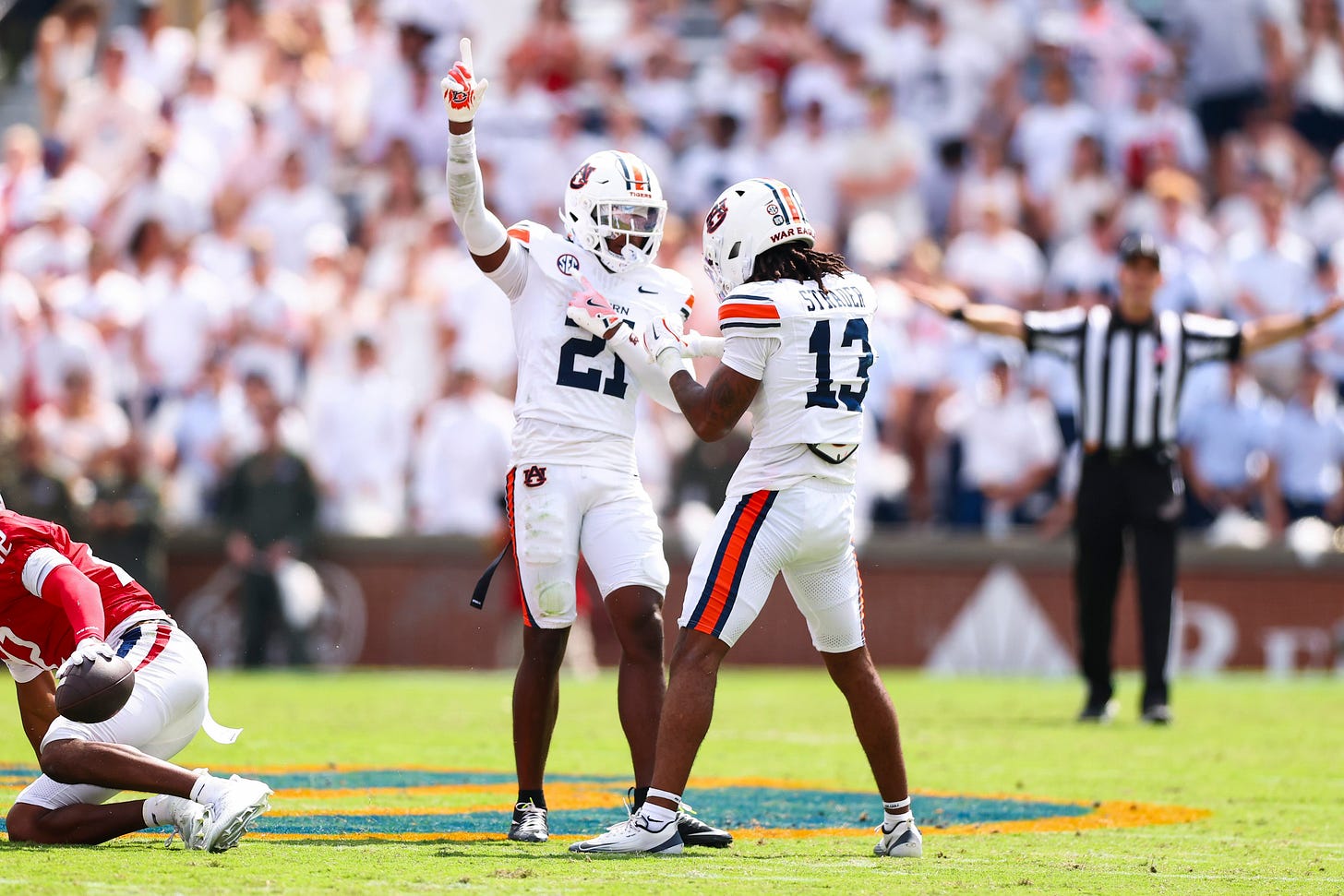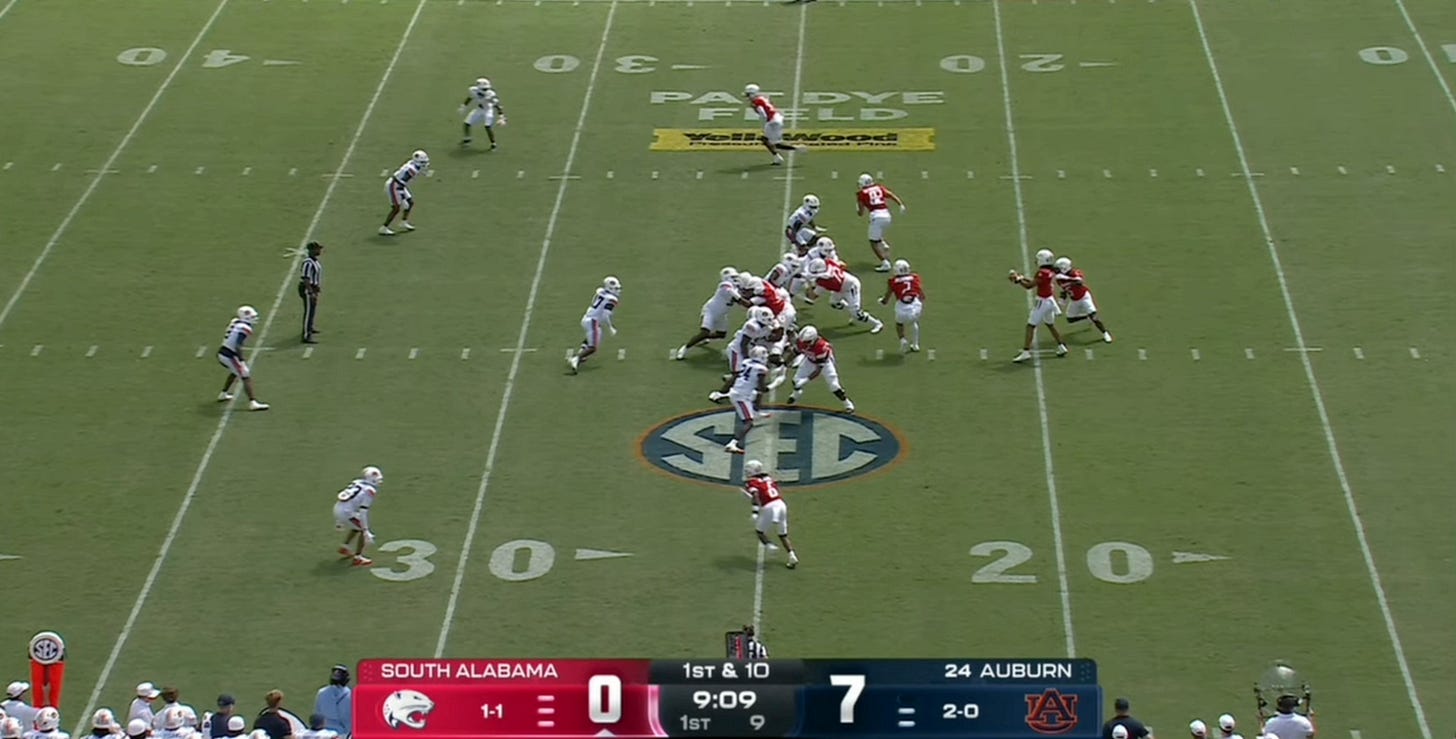Film Room: What's wrong with Auburn's pass defense?
The Tigers spent a lot of the South Alabama game struggling in coverage again. Can they get the issues fixed in time for SEC play?
AUBURN — If you had to pick the Auburn football position group you felt most confident in before the 2025 season began, chances are you were going with the wide receivers — with the defensive backs being a close second.
And, given the shaky play of the offense and the new quarterback situation, some might have even gone with the secondary anyway.
Auburn headed into the second season under defensive coordinator DJ Durkin bringing back its top two cornerbacks (Kayin Lee and Jay Crawford) and two of its top three safeties (Kaleb Harris and Sylvester Smith).
The Tigers further added to those ranks with a pair of Group of Five standout corners (Rayshawn Pleasant and Raion Strader) and a true freshman class with five blue-chip prospects. Auburn was also excited to get Champ Anthony back from a devastating leg injury.
While Auburn’s pass defense was a middle of the road one in 2024, ranking No. 66 nationally and No. 9 in the SEC in yards per attempt, there was real confidence that the Tigers would take a step forward this fall. Preseason camp was filled with eye-catching moments from the defensive backs. The hype was real.
Then, in Week 1, Auburn gave up 419 passing yards — the most the program had allowed since a Hugh Freeze-coached Ole Miss put up 465 back in 2016 — to Baylor. The Tigers won, just like they did in 2016. And they knew that the Bears, who would throw for 440 a week later in a win over SMU, had a prolific passing attack.
But Auburn coaches and players talked plenty after the opener about how it didn’t come close to its defensive standard in that win. And, two weeks later, they were saying some of the very same things after a two-touchdown win over South Alabama.
The final passing numbers from Bishop Davenport and the Jaguars’ offense don’t tell the full story, admittedly. Davenport threw for 170 yards and an average of 6.5 per attempt. Those are pedestrian stats, given the state of modern college football.
Try telling anyone at the end of the third quarter Saturday afternoon in Jordan-Hare Stadium that Davenport wasn’t having his way with Auburn’s pass defense, though. At one point, he was 15-18 passing for 164 yards and two touchdowns.
That’s an average of 9.11 yards per attempt and a completion percentage of 83.3%. His three incompletions were a harmless early deep shot, an interception that went off his receiver’s hands and a throwaway. He hadn’t been sacked to that point and hadn’t even had to scramble away from pressure.
Davenport went 3-8 passing for just 6 yards in the fourth quarter, and he would lose the ball on a strip sack by Auburn freshman edge rusher Jared Smith. That finish would bring his numbers back down to earth, but it didn’t change how most of the game went against an Auburn pass defense that was supposed to be a strength.
Now Auburn is about to head into an SEC schedule that only looks tougher after the first three weeks of the season.
The opener this weekend is at Oklahoma, who has the SEC’s top passer in Washington State transfer John Mateer. The following game is a road trip to Texas A&M, which just saw Marcel Reed throw for 340 yards in a road win at Notre Dame. And rival Georgia just won a shootout at Tennessee with new quarterback Gunner Stockton going 23-31 for 304 yards and two clutch touchdowns.
As Freeze said Saturday after the win over South Alabama, the way Auburn played defensively isn’t close to the standard needed to win in the SEC.
In this week’s edition of the Film Room, we’ll take a closer look at what ailed Auburn’s pass defense against South Alabama and what will have to be fixed ASAP.
Important disclaimer up front: I don’t know the exact play calls. I don’t have all the answers. I feel less confident about breaking down defense than I do offense. I hope to give everyone reading this a deeper understanding of what’s gone wrong with Auburn’s pass defense, but I am nowhere near an Xs and Os expert.
With that in mind, let’s take a look at the film, starting with an important area that gave the Tigers fits Saturday against the Jaguars.
Run-pass options (RPOs) are tough to cover. There’s a reason why they’ve become so popular at every level of football. It’s modern triple option, where an offense is banking on the fact that a defense can’t cover everything, every single time.
The offensive line is pushing ahead like it’s a running play, which already puts linebackers in a tough spot. If there’s space available, the handoff to the running back will be made, or the quarterback will keep it for his own run. If you overplay the run, though, there are options to pull the ball back and throw it to a receiver with space.
Defending the RPO is a lot like defending the classic option: It all comes down to proper assignment football. If everyone does their job, everything should be accounted for on defense. The trouble comes when a player gets out of position or doesn’t stick to his rules. That’s when the offense attacks.
On Saturday, Davenport dropped back to pass 29 times. That doesn’t count the three plays in which Auburn was flagged for penalties, including a third-and-10 holding and a fourth-and-4 pass interference in the fourth quarter. It does count a 1-yard fly sweep “pop pass,” though.
Of those 28 true passing opportunities, eight of them were RPOs. South Alabama racked up 81 yards on those plays for an average of 10.13 per snap. Two of its three longest plays of the day, including its first touchdown, were on RPOs.
South Alabama went with an RPO on its first play of the game. Shortly after the snap, you can tell that Auburn’s linebackers are playing the run — Robert Woodyard Jr. triggers down, while Xavier Atkins stays in his lane next to him to fit the run.
Demarcus Riddick is the edge rusher on the right side, staying home to prevent Davenport from running with the ball and is likely also being mindful of the H-back (tight end Miller McCrumby, No. 3) in motion. South Alabama is leaking another tight end, Trent Thomas (No. 82), out behind Riddick.
But everyone is still going to be accounted for here. Kayin Lee has the receiver on the right side of the formation, while it appears that safety Jahquez Robinson is going to have to be the one to take care of Thomas leaking out.
Instead, Robinson comes all the way down into the box and is in no man’s land. You can even see Lee, dropping back deeper, point toward Thomas in the flat. It’s a wide-open, easy throw for Davenport. Thomas gets the ball and turns upfield, breaking Lee’s first tackle attempt and getting extra yards past the first-down marker.
The opening play turns out to be a bad omen for what was to come the rest of the way.




